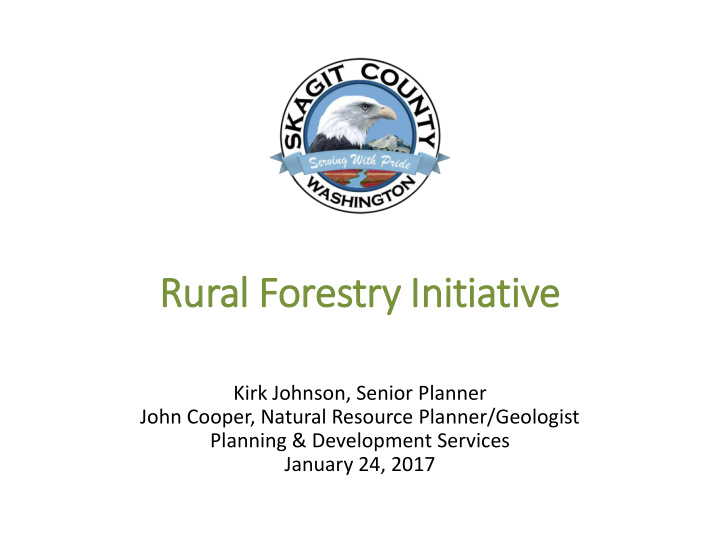



Rural Forestry ry In Initiative Kirk Johnson, Senior Planner John Cooper, Natural Resource Planner/Geologist Planning & Development Services January 24, 2017
RFI Overview • The Forest Advisory Board (FAB) asked the County to implement the concept of the Rural Foresty Initiative (RFI) • Board of County Commissioners placed RFI on the Department’s work program • Department is working on RFI together with transfer of jurisdiction for forest land conversions from DNR to the County and land clearing rules
RFI Overview • Environmental review for development : – County reviews under critical areas ordinance (CAO) • Environmental review for forest practices : – Dept of Natural Resources (DNR) reviews under forest practice rules.
RFI Overview • What happens when development and forest practices are proposed on same parcel ? • That’s what the Rural Forestry Initiative seeks to address
Existing Parcel Option 1 – County reviews entire parcel under CAO – Critical areas protected under County rules – Forest practices may proceed under DNR review, after critical areas are protected by County – Gives property owner maximum flexibility for development – Option chosen by most landowners
Existing Parcel – Option 1 Entire parcel reviewed under CAO
Existing Parcel Option 2 – County only reviews developed area, plus 200' – 300' buffer, under CAO • Review for landslide hazards may consider surrounding topographic/geologic features – Forest practices proceed on remainder of parcel under DNR review – This RFI-friendly option already available on existing parcels
Existing Parcel – Option 2 • Only developed area reviewed under CAO • Review for landslide hazards may consider surrounding topographic/geologic features • Forestry on remainder reviewed under forest practice rules
Land Division Law Overview • State law and county code assume land divisions are for development purposes • Laws seek to ensure all necessary infrastructure/utilities installed at time of land division • Goal is to protect lot purchasers and require development to cover its costs and impacts
CaRD Land Division – Current Practice • Development parcels are identified, clustered
CaRD Land Division – Current Practice • Remaining open space is either: • reviewed under critical areas • placed in OS-PA (protective easement: no development, no forestry) • If critical areas are protected, forest practices under DNR rules may occur
CaRD Land Div ivis ision – Proposed RFI I Option County reviews developed area (plus buffer) under CAO – Review may consider surrounding topography/geology for geohazard risks to the developed lots Remainder placed in Open Space-Forestry (a new open space designation) – Forest practices in OS-F, when they occur, would be reviewed by DNR under forestry rules
CaRD Land Division – RFI Option
CaRD Land Div ivis ision – RFI I Option
CaRD Land Division – RFI Option
CaRD Land Div ivis ision – RFI I Option
CaRD Land Div ivis ision – RFI I Option Additional issues being explored: • Stormwater management in developed area • How to address windthrow risk (blown down trees) • Forest Management Plan
RFI Next xt Steps • Department continuing to discuss this issue with Forest Advisory Board • Also reviewing other County examples and hearings board and case law • Expect to have final proposal by meeting of BCC and PC in early March
King County Approach • Applicant submits forest management plan, indicating how environmental resources will be protected under forest practice rules • King County staff walk site, identify critical areas that may be affected by/affect development • These are placed in Critical Areas tract
King County Approach • Area where development will occur is reviewed under critical areas ordinance • Area where forestry will occur, and there is no interaction between the developed area and forestry, is placed in a Resource Tract subject only to DNR rules. • Critical areas in the Resource Tract that may be affected by the development, or may negatively affect the development (e.g. landslides), are put in Critical Areas Tract within Resource Tract, and protected under Critical Areas Ordinance
Recommend
More recommend